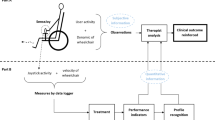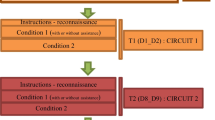Abstract
In this paper, we propose a learning assessment method based on the analysis of learner’s behavioural style. This method was first applied for wheel-chair driving tasks because it is simple and risk-free, but unusual for users. Seven classic performance indicators based on joystick control were used to characterise the users’ driving style. We assumed that the learning effectiveness of the users can be evaluated by comparing their driving style with the reference ones, which could be extracted from experienced users. The evaluation was carried out for six novice users and eight experienced users. The users were asked to carry out several typical driving tasks for seven trials at first. The fuzzy C-means clustering method was used with the data of the experienced users to obtain the reference driving styles. Next, an evaluation was performed for novice users by comparing their driving styles with the reference ones. The results showed that, for all of the experienced users, their driving styles could be classified into two reference types. In addition, there was no significant difference in their driving styles from one trial to another, even for a user with disabilities, which means that their driving style was stable. On the other hand, novice users had switching behaviours during the learning phase; however, after eight additional trials, each novice user’s driving style converged to one of the two identified reference types, meaning that the novice users could achieve a stable performance after learning, which was also validated by an expert therapist.










Similar content being viewed by others
Notes
http://www.ceremh.org, national center on mobility aid.
References
Bédard M, Parkkari M, Weaver B, Riendeau J, Dahlquist M (2010) Assessment of driving performance using a simulator protocol: validity and reproducibility. Am J Occup Ther 64(2):336–340
Bezdek J, Ehrlich R, Full W (1984) FCM: the fuzzy c-means clustering algorithm. Comput Geosci 10:191–203
Bezet O, Cherfaoui V, Bonnifait P (2006) A system for driver behavioral indicators processing and archiving. In: 9th IEEE conference on intelligent transportation systems (ITSC’06), vol 45, pp 799–804
Canale M, Malan S (2002) Analysis and classification of human driving behaviour in an urban environment. Cogn Tech Work 4(3):197–206
Candiotti J, Kamaraj D, Daveler B, Chung C, Grindle G, Cooper R, Cooper R (2019) Usability evaluation of a novel robotic power wheelchair for indoor and outdoor navigation. Arch Phys Med Rehabil 100:627–637
Chase J, Bailey DM (1990) Evaluating the potential for powered mobility. Am J Occup Ther 44(12):1125–1129
Chen J, Yeasin M, Sharma R (2003) Visual modelling and evaluation of surgical skill. Pattern Anal Appl 6:1–11
Cooper R, Thorman T, Cooper R, Dvorznak M, Fitzgerald S, Ammer W, Song-Feng G, Boninger M (2002) Driving characteristics of electric-powered wheelchair users: how far, fast, and often do people drive? Arch Phys Med Rehabil 83(2):250–255
Deepan C, Dicianno B, Schmid M et al (2014) Quantifying power wheelchair driving ability. In: Rehabilitation engineering and assistive technology Society of North America conference, Indianapolis
Dong W, Li J, Yao R, Li C, Yuan T, Wang L (2016) Characterizing driving styles with deep learning. ArXiv e-prints
Dunn J (1974) A fuzzy relative of the isodata process and its use in detecting compact well-separated clusters. J Cybern 3(3):1149–1158
Durkin J (2002) The need for a child led assessment tool for powered mobility users. Technol Disabil 14(4):163–171
Durkin J (2009) Discovering powered mobility skills with children: ’responsive partners’ in learning. Int J Ther Rehabil 16(6):331–341
Fehr L, Langbein W, Skaar S (2000) Adequacy of power wheelchair control interfaces for persons with severe disabilities: a clinical survey. J Rehabil Res Dev 37(3):353–360
Field D, Livingstone R (2018) Power mobility skill progression for children and adolescents: a systematic review of measures and their clinical application. Dev Med Child Neurol 60(10):997–1011
Ge Y, Qu W, Jiang C, Du F, Sun X, Zhang K (2014) The effect of stress and personality on dangerous driving behavior among chinese drivers. Accid Anal Prev 73:34–40
Javanmardi S, Bideaux E, Trégouët JF, et al (2017) Driving style modelling for eco-driving applications. In: The 20th World congress of the international federation of automatic control, Toulouse, pp 13866–13871
Johnson DA, Trivedi MM (2011) Driving style recognition using a smartphone as a sensor platform. In: 14th International IEEE conference on intelligent transportation systems, pp 1609–1615
Kirby R (1997) Principles of wheelchair design and prescription. In: Principles of neurologic rehabilitation, pp 465–481
Kirby R, Miller W, Routhier F et al (2015) Effectiveness of a wheelchair skills training program for powered wheelchair users: a randomized controlled trial. Arch Phys Med Rehabil 96(11):2017–2026
Kirby R, Smith C, Parker K et al (2017) The wheelchair skills program manual. Dalhousie University, Nova Scotia
Kruskal W, Wallis W (1952) Use of ranks in one-criterion variance analysis. J Am Stat Assoc 47:583–621
Lanatà A, Valenza G, Greco A, Gentili C, Bartolozzi R, Bucchi FEA (2015) How the autonomic nervous system and driving style change with incremental stressing conditions during simulated driving. IEEE Trans Intell Transp Syst 16(3):1505–1517
Lefevre S, Carvalho A, Gao YQ et al (2015) Driver models for personalized driving assistance. Veh Syst Dyn 53(12):1705–1720
Levine S, Bell D, Jaros L et al (1999) The navchair assistive wheelchair navigation system. IEEE Trans Rehabil Eng 7(4):443–451
Livingstone R (2010) A critical review of powered mobility assessment and training for children. Disabil Rehabil Assist Technol 5(6):392–400
Ly MV, Martin S, Trivedi MM (2013) Driver classification and driving style recognition using inertial sensors. In: IEEE intelligent vehicles symposium (IV), pp 1040–1045
MacQueen JB (1967) Some methods for classification and analysis of multivariate observations. In: Cam LML, Neyman J (eds) Proceedings of the fifth Berkeley symposium on mathematical statistics and probability, vol 1. University of California Press, Berkeley, pp 281–297
Miller DP, Slack MG (1995) Design and testing of a low-cost robotic wheelchair prototype. Auton Robots 2(1):77–88
Miro J, Black R, Andonovski B, Dissanayake G (2013) Development of a novel evidence-based automated powered mobility device competency assessment. In: IEEE international conference on rehabilitation robotics, Seattle
Moghaddam A, Pineau J, Frank J, Archambault P, Routhier F (2011) Mobility profile and wheelchair driving skills of powered wheelchair users: sensor-based event recognition using a support vector machine classifier. In: 33rd Annual international conference of the IEEE EMBS, Boston, pp 7336–7339
Mohamed NA, Ahmed MN, Farag A (1999) Modified fuzzy c-mean in medical image segmentation. In: IEEE international conference proceedings of the acoustics, speech, and signal processing, ICASSP ’99, vol 6. IEEE Computer Society, Washington, DC, pp 3429–3432
Montesano L, Diaz M, Bhaskar S, Minguez J (2010) Towards an intelligent wheelchair system for users with cerebral palsy. IEEE Trans Neural Syst Rehabil Eng 18(2):193–202
Newell A, Gregor P (1999) Extra-ordinary human–machine interaction: what can be learned from people with disabilities? Cogn Tech Work 1(2):78–85
Nilsson L, Durkin J (2014) Assessment of learning powered mobility use—applying grounded theory to occupational performance. J Rehabil Res Dev 51(6):963–974
Nuttin M, Demeester E, Vanhooydonck D, Brussel HV (2001) Shared autonomy for wheelchair control: attempts to assess the user’s autonomy. In: Levi P, Schanz M (eds) Autonome mobile systeme, Informatik Aktuell. Springer, Berlin, pp 127–133
Pellegrini N, Guillon B, Prigent H, Pellegrini M, Orlikovski D, Raphael J, Lofaso F (2004) Optimization of power wheelchair control for patients with severe Duchenne muscular dystrophy. Neuromuscul Disord 14(5):297–300
Ramze M, Lelieveldt B, Reiber J (1998) A new cluster validity index for the fuzzy c-mean. J Pattern Recognit Lett 19:237–246
Rath JJ, Senouth C, Popieul JC (2019) Personalised lane keeping assist strategy: adaptation to driving style. IET Control Theory Appl 13(1):106–115
Sathyanarayana A, Sadjadi S, Hansen JH (2012) Leveraging sensor information from portable devices towards automatic driving maneuver recognition. In: IEEE 15th International conference on intelligent transportation systems (ITSC), pp 660–665
Schwarz C, Gaspar J, Brown T (2018) The effect of reliability on drivers’ trust and behavior in conditional automation. Cognition Tech Work, pp 1–14
Shan S, Sandham W, Granat M, Sterr A (2005) Mri fuzzy segmentation of brain tissue using neighborhood attraction with neural-network optimization. IEEE Trans Inf Technol Biomed 9(3):459–467
Sorrento G, Archambault P, Routhier F, Dessureault D, Boissy P (2011) Assessment of joystick control during the performance of powered wheelchair driving tasks. J Neuroeng Rehabil 8:31
Suzurikawa J, Kamo M, Iida N et al (2016) Quantitative evaluation of changes in joystick operation induced by downhill turning prevention control for a power wheelchair. IEEJ Trans Electron Inf Syst 136(9):1318
Sysoev M, Kos A, Guna J, Pogacnik M (2017) Estimation of the driving style based on the users’ activity and environment influence. Sensors (Basel) 17(10):1–15
van der Slikke R, Berger M, Bregman D, Veeger H (2016) From big data to rich data: the key features of athlete wheelchair mobility performance. J Biomech 49(14):3340–3346
Wang Y, Qu W, Ge Y, Sun X, Zhang K (2018) Effect of personality traits on driving style: psychometric adaptation of the multidimensional driving style inventory in a chinese sample. PLoS One 13(9):1–17
Wilcoxon F (1945) Individual comparisons by ranking methods. Biom Bull 1(6):80–83
William D (2011) What is assessment for learning? Stud Educ Eval 37(1):3–14
Winyard G, Luker C, Nichols P (1976) The uses and usefulness of electrically powered indoor wheelchairs. Rheumatol Rehabil 15(4):254–263
Wood JM, Worringham C, Kerr G, Mallon K, Silburn P (2005) Quantitative assessment of driving performance in Parkinson’s disease. Neurol Neurosurg Psychiatry 76:176–180
Yang L, Ma R, Zhang H, Guan W, Jiang S (2018) Driving behavior recognition using eeg data from a simulated car-following experiment. Accid Anal Prev 116:30–40
Acknowledgements
The authors would like to thank all the subjects in the evaluations. We would also like to thank the Foundation Motrice (http://www.lafondationmotrice.org/) and the CEREMH for their assistance on the test.
Author information
Authors and Affiliations
Corresponding author
Ethics declarations
Conflict of interest
Amina Gacem declares that he has received research grants from the Foundation Motrice. Eric Monacelli, Olivier Rabreau, Ting Wang and Tarik Al-ani declare that they have no conflict of interest.
Informed consent in studies with human subjects
All procedures followed were in accordance with the ethical standards of the responsible committee on human experimentation (institutional and national) and with the Helsinki Declaration of 1975, as revised in 2008 (5). Informed consent was obtained from all patients for being included in the study.
Additional information
Publisher's Note
Springer Nature remains neutral with regard to jurisdictional claims in published maps and institutional affiliations.
Rights and permissions
About this article
Cite this article
Gacem, A., Monacelli, E., Wang, T. et al. Assessment of wheelchair skills based on analysis of driving style. Cogn Tech Work 22, 193–207 (2020). https://doi.org/10.1007/s10111-019-00563-6
Received:
Accepted:
Published:
Issue Date:
DOI: https://doi.org/10.1007/s10111-019-00563-6




